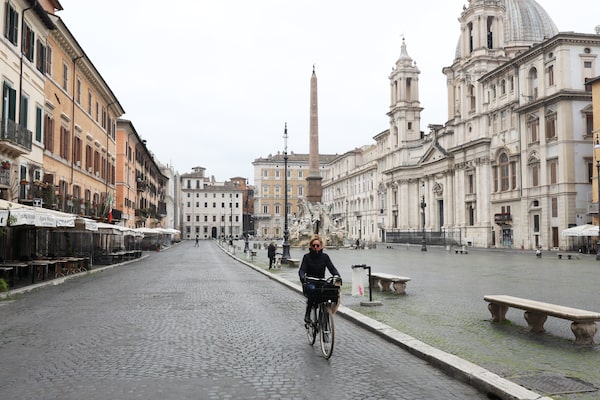
A woman is seen cycling in a completely empty Piazza Navona on March 13, 2020, in Rome.Marco Di Lauro/Getty Images
My one extensive outing during the six-week Italian lockdown came on Monday, when I put my media credentials to work and wandered the streets of central Rome for two hours with only perfunctory questioning from the quarantine police. I was astonished: I had never seen Rome so eerie, yet so appealing.
With 99 per cent of the traffic gone, I could breathe without choking on diesel fumes, walk on streets that were never designed for cars and motorcycles and hear conversations from open windows. The parked cars seemed like dead, alien beasts – useless and entirely out of place.
And all I could think was: Let’s not waste the COVID-19 crisis, let’s finish off what Rome and other car-choked cities had already started and rid the streets forever of this most inefficient, greedy and polluting form of transport.
Coronavirus guide: Updates and essential resources about the COVID-19 pandemic
Of course, that could never happen overnight, but in my dreams I thought that enlightened mayors everywhere, captivated by their cities’ suddenly clean, car-free streets, would accelerate their urban renewal plans. Cars would be forever banned from many, perhaps most, streets in the centre and restricted elsewhere, sidewalks would be widened, bike paths made ubiquitous and public transportation would be extended and rejuvenated, perhaps even made free, as it is in Luxembourg. A big drop in urban carbon-dioxide emissions would be an important side benefit.
Then I talked to Brent Toderian, the urbanologist who was Vancouver’s chief planner until 2012; he now consults for urban planners and developers around the world.
He raised a depressing scenario that would see the postcoronavirus world embrace more cars, not fewer, because of the desire for physical distancing. “Our biggest risk is that people will feel the need to move away from public transit,” he said. “Car companies will use this pandemic to convince us that cars are safe and transit is not.”
Early evidence suggests he may be right. Wuhan, the Chinese city that was the first COVID-19 epicentre, is out of quarantine and coming back to life. Bloomberg reported last week that Wuhan car sales have bounced back, with sales already reaching their precrisis level. The report said that dealers were seeing families buying second cars “because they see personal vehicles [as] safer than public transportation.”
Given the dire state of the global auto industry, it’s hard to imagine that it could experience a fairly rapid recovery. But that scenario can no longer be excluded if public transportation is seen as a potentially fatal experience.
Car factories everywhere are closed, although plans are now being made to reopen them. The process is bound to be slow at first, since the factories are really assembly plants that rely on suppliers scattered around the world. Many of the small and medium-sized suppliers are in financial distress and some will go bankrupt. One missing car part can bog down an entire assembly line.
Still, the eventual return to robust sales is entirely possible once the supply disruptions are fixed, all the more since car financing is cheap and the collapse in crude oil has sent gasoline prices tumbling. The desire for physical distancing will also give a boost to autonomous cars, which are under development by every major auto company. Even before anyone heard of COVID-19, tech gurus were pushing autonomous vehicles as potential competitors to public transportation.
Today, the idea of a car that comes to your door and gives you your own seat is even more compelling. There must be millions of commuters who would now avoid crowded subways and buses, just as they now would avoid crowded supermarkets. Supermarkets can control their doors to to limit the number of shoppers inside at the same time. Similar controls on buses and subways would be much harder to put in place. If the frequency of buses and subways were, say, tripled, physical distancing might be possible, but no city has the financial or logistical ability to add that much capacity in a hurry.
City streets that are more jammed with traffic than ever would roll back the clock by years, even decades, virtually overnight. London, Paris, Vancouver, Berlin and dozens of other big cities have put in traffic restrictions, built up bicycle-path networks, closed off streets and squares and introduced sporadic car-free days, as Rome has done. The idea was return to the people some of the massive amounts of real estate handed over to cars.

A man wearing a protective mask rides his electric scooter in a bike lane in Bogota, Colombia, on March 16, 2020.Fernando Vergara/The Associated Press
Last month, Bogota, the capital of Colombia, announced that its ciclovia – the city’s 120-kilometre network of streets that was devoted solely to bikes one day a week – would be extended all week to get people out of their cars and take the pressure off the public-transport system as coronavirus fears intensify. Few cities would have the imagination or public support to launch a similar plan. For many cities, especially those in North America, low-density housing and suburban sprawl mean there is no alternative to the car.
You will not hear car companies admit that the coronavirus crisis could have a silver lining for them – that would be crass. But absent an effective vaccine (which could be a year or two away), car use is likely to rise beyond precrisis levels once quarantines are lifted. That’s great news for the car companies, their employees and their shareholders; not so great for city livability.
Rome lay empty on Monday as a government-ordered shutdown to contain the spread of the coronavirus, under which all non-essential movements are banned and shops and parks are closed, continues.
The Associated Press
Sign up for the Coronavirus Update newsletter to read the day’s essential coronavirus news, features and explainers written by Globe reporters and editors.
 Eric Reguly
Eric Reguly